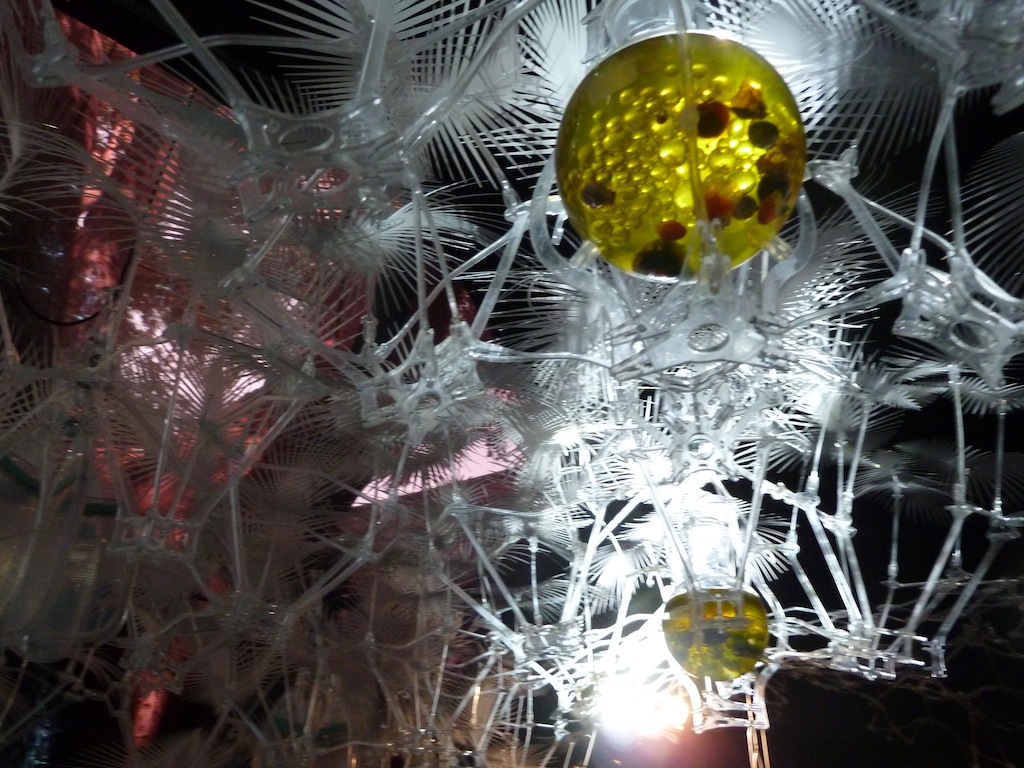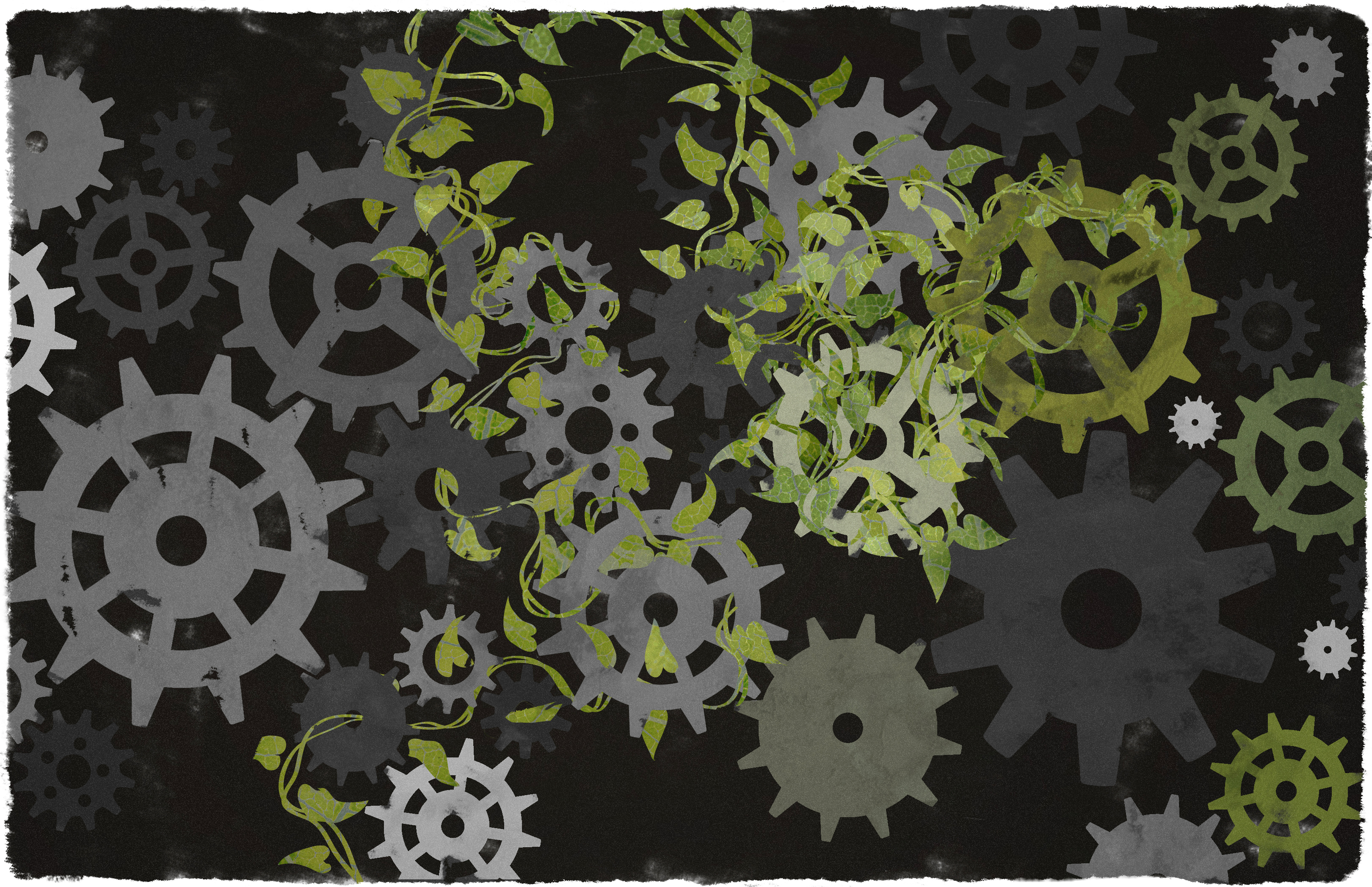Speculative Science
With this article on living architecture by Rachel Armstrong, the curated digital releases of The Five Thousand Pound Life turn their focus to the nexus of design and technology. Adding to thoughts on economics and governance, this commissioned writing reveals new entry points to a rich and evolving project—points that will continue to be developed through time. Efforts to imagine a prosperous future that disarms climate change shouldn’t be relegated to a marginal sustainability sector—they should transform established fields and forge connections between them in intelligent new ways.
A TED Fellow and the co-director of AVATAR (Advanced Virtual and Technological Architectural Research) at the University of Greenwich, Armstrong nurtures possibilities for collaboration between science and architecture. Her approach is at once innovative, propositional, and critical in its pursuit of progress—filtering the knowledge of our natural world through the visionary tradition of architecture. Armstrong challenges the status quo with research that defies easy categorization, yet it is this approach that forges new territory and expands the boundaries of our thinking.
Beyond discarding the linked good and bad of industrial culture, she imagines something better to take its place. By embracing the “restless nature of the material world,” we reach the enticing prospect of ecological technologies that position change as a source of power, not vulnerability. The static architecture of the industrial age peaks at the moment construction is completed; a living architecture leverages the unyielding change of nature to renew its relevance into the future.
While climate change encompasses many different events, its defining characteristics are its unpredictability and constantly shifting nature. Using this as a point of departure, I situate my work within the complex entanglements of science, experience, and phenomenology. My research addresses the pragmatic notion of our world being in a perpetual state of flux and embraces the properties of matter that exist at far-from-equilibrium states. It establishes how it may be possible, in a very literal sense, to harness the restless nature of the material world as a form of technology that can dynamically respond to a constantly changing environment; how it may be possible to secure our long-term prosperity by integrating scientific and cultural perspectives. Science can cope with empirical events, such as rising concentrations of carbon dioxide, by technologically “fixing” them into solid mineral form; culture can engage differently with the complex social experiences of climate change. For example, growing an architectural-scale “living reef” and marine garden underneath the foundations of the coastal city of Venice might not only protect against the destructive effects of acqua altabut also offer a new kind of architectural experience in the form of a synthetic “marine garden.”
Speculative Technology
Technology is central to living more ecologically, since the technologies to which we have access embody and reflect the way we see and experience the world.
Our dominant technological paradigm is based on a mechanical/industrial culture, which replaced agrarian technologies during the Industrial Revolution and has specific environmental impacts. Machines consume natural resources and energy—sourced in concentrated form as fossil fuels—and metabolize them into carbon dioxide and other compounds, which generally have little usefulness to natural systems. While these technologies have brought immeasurable benefits to communities and have raised standards of living and global wealth, they have also produced great environmental harm as they damage the ecosystems that compose the living world. This is more than merely a fundamental incompatibility between natural and mechanical metabolisms as observed by Michael Braungart and William McDonough[1]; it is the consequence of mechanical/industrial technologies operating on a global scale, using the same metabolism that creates products and waste, which cannot be easily recycled into our natural systems.
If an ecological worldview understands that our environment is constantly undergoing change, then ecological technologies are designed to be compatible with this perspective. Yet, contemporary technologies stem from a machine paradigm that is based on a series of connected inert objects that perform useful work when powered by external energy sources. Therefore, in order to move from an industrial to an ecological worldview, we must identify process-led solutions that harness the intrinsic energy of far-from-equilibrium systems. This energy is found by coupling active agents together to produce a new kind of technological platform. Such a technology can deal with the dynamic nature of our planetary systems, as it is fundamentally sensitive to environmental changes. However, these do not yet exist in any commercial form. Therefore, my research investigates the technological potential of cutting-edge scientific developments by using propositional and speculative approaches. In examining the potential applied functions of emerging technologies, their benefits and pitfalls may be considered from a cultural perspective. Although such factors are complex, they ultimately shape our choices and establish the limits of how we may use emerging technologies to radically influence the process of human development.

Dynamic droplets of alkaline solution in oil may be considered in a technological context since they can be directed to perform meaningful work by changing their internal and external chemistry. | photo: Rachel Armstrong
Technological Monoculture
While our environment is resilient enough to recover from small-scale perturbations in ecosystems, the advances in mechanical technologies, accelerated through digital computing, are having a profound impact on environmental systems. Machines are taking an irreversible toll on our ecologies and are therefore damaging the viability of our industrial culture. Yet, it is not the technology per se that causes irreversible damage to ecosystems. Rather, it is the scale and intensity at which we unleash identical operating systems on the landscape that does not give our ecosystems enough time to adapt and recover from our constant industrial assault. In the Modern Age there is no “fallow” period of industrialization. Therefore our worldwide adoption of industrial methods is magnifying the negative ecological impacts of mechanical technologies by pushing our ecosystems towards tipping points beyond which environmental recovery becomes impossible.
Technological Diversity
A knee-jerk response to this situation may be to adopt a nostalgic, anti-technology approach that looks to more innocent environmental times (such as in Paul Kingsnorth’s notion of “dark” ecology). A more promising alternative is to expand the technological portfolio of the 21st century to embrace many different kinds of technologies. These could be designed to have an even broader range of metabolic types that can process a variety of locally available resources. If technological systems could be powered by different kinds of energy, the waste from such a system might be used as the fuel for another “metabolic” type of technology. For example, energy in the form of sugar produces alcohol and heat, rather than energy in the form of oil, which yields carbon dioxide and water. At the same time, all types must achieve a common purpose through global manufacturing methodologies to support our growing world population. We don’t want to establish a different technological monoculture that depletes the world’s sugar supplies and creates excess alcohol!
While the needs of populations cannot be met through local small-scale processes alone, we may be able to produce developmental platforms by diversifying the range of metabolisms used by technological systems. If different metabolic types of technology were used in different ways to promote a more diverse range of exchanges, they could become a new paradigm for human development that promotes rather than destroys living systems. For example, biomass from an algaeponics unit could be used to feed methane-producing bacteria, whose combustion products could then be re-fed into the algae system to nurture them. The challenge we face is that machine thinking is so deeply ingrained in our culture that it is difficult to imagine non-mechanical technology. Habitually, we solve challenges by considering inert matter at equilibrium states and develop hierarchies of objects and machines for living in, when we actually need to find ways of designing and engineering for, and with, change.

Glass vials containing dynamic chemistries, which appear as golden orbs in this cybernetic “Hylozoic Ground” installation by Philip Beesley, slowly respond to the presence of carbon dioxide by changing color. | photo: Rachel Armstrong
Living Technology
Through the lens of complex systems and networks of material flows that form our terrestrial ecologies, new technologies may be possible that take neither a top-down nor a bottom-up approach to problem solving, but rather actively couple the ongoing dynamic exchanges that occur when matter is at far-from-equilibrium states. Such “living” technologies possess some of the properties of living things but may not have the full status of being truly “alive.” They have qualitatively different characteristics than machines, being emergent, contingent, and co-constructed by their participants. Through their ability to couple materials together, they actively facilitate the convergence of diverse media and even disciplines. These confluences have allowed researchers to appreciate the opportunities that exist when advanced, combined, and emergent technologies are deliberately brought together in contexts that catalyze new relationships between them. For example, NBIC (Nanotechnology, Biotechnology, Information technology, Cognitive science) initiatives represent convergent practices that promise disruptive innovation that can impact our society and economy. The value of “Arts” in STEAM (Science, Technology, Engineering, Arts, Mathematics) is also being recognized in these new fields as actively contributing to technological innovation through the development of speculative instruments that produce experiments, models, and prototypes to explore possibilities that have not yet been midwifed into reality. This is particularly important when technologies are emerging, as their outcomes may have profound cultural and social impacts as tipping points of technological transformation are reached—especially when they are reflected back into contemporary practice. Such iterative processes—based on proposition, experiment and reflection—may be guided towards meeting specific societal needs to assist in the mindful and socially responsible development of emerging technologies and enable stakeholders to spread the risk of their investment in new ventures.
Living Architecture
Our buildings house technology, and therefore the kinds of technologies that are contained within our living spaces may be regarded as being an interface of exchange between our habitats and our environment. Consequently, the built environment has a unique role in diversifying the species of technological platforms that underpin human development. Our metropolitan landscapes organize and host the technologies that we use on a daily basis. Currently, our designed environments are equipped with infrastructures that are optimized to feed mechanical and digital systems, perhaps best typified by the legions of air conditioners poking out of skyscraper walls, which heat outside air on hot days. Indeed, this role in housing our mechanical technologies on urban and industrial scales means that buildings account for around 40% of carbon emissions. Yet, the living infrastructures that support life’s processes are fuelled by elements such as, air, water, heat, and earth. These elements not only enhance our own wellbeing, but also support living technologies. For example, in modern homes, bathrooms and kitchens are designed to waste these resources—to drain precious drinking water straight into waste systems after use—rather than recirculate it for further use. Even if the water is not potable, we need to design systems in which grey water can be used to transport other materials that have been harvested and recycled, such as salts or insoluble sediments through a home.
We need to find ways of designing and engineering for, and with, change
TED Fellow Damian Palin suggests that we can mine minerals from seawater, and believes it would be possible to apply these kinds of technologies within our living spaces or communities. By considering what it means to design optimally using living infrastructures, we are also increasing our chances of changing the technological paradigm underpinning the construction of a building, such that our living spaces may remediate and even restore ecologies. Examples include bioprocessing systems (such as anaerobic composters that break down organic waste) or functional units such as algae and bacterial bioreactors that perform as a kind of micro-agriculture and produce immediately useful substances such as oils, alcohols, and biogas. These technologies operate around hubs and confluences where the flow and exchange of matter is possible through “organs” within buildings, which can be connected in parallel to the function of other organs and create a physiological space within an architectural site. These active realms, or “hyper” bodies, also extend into the exterior environment, where they may link to other dynamic systems and begin to demonstrate characteristic features that may shape the formation of communities and regions around a variety of abundant resources like light, carbon dioxide, or even guano. Ultimately our cities, and even our own identities, may be shaped by real—not figurative—metabolic flows and exchanges. These dynamic physical systems will form the basis of a new kind of 21st century ecology that is not built on virtual currencies, but material ones that could coexist alongside global stock markets and national banking systems.
Towards a Practice of Living Architecture
The challenge with living technologies and the construction of architectural ecologies is that they are not established practices. The role that the architect plays in imagining, designing, and constructing with them is critical in shaping their future. Yet, when living technologies are imagined to “sustain” operations within closed-loop systems, their performance is greatly constrained. However, when energy, time, and space are inserted into living technologies by elemental infrastructures such as, air, heat, water, and earth, the offset in transformations can persist over much longer periods. Within open systems, new pathways and sets of exchanges can take place and even possess the capability to respond to change as environmental cues alter and evolve over time.

This photograph of a building reflected on the surface of a Venice waterway creates a poetic image using the surface of the water as a sensitive interface that responds to the action of elemental forces such as light and wind. These images display events that are taking place at the micro scale, which start to suggest a topology where convergent emerging technologies may become environmentally responsive in ways that may be technological harnessed to transform our cities. | photo: Rachel Armstrong
When dealing with an emerging technological platform, architects may therefore find it useful to apply speculative approaches—ones that take a probabilistic rather than deterministic view of the future—to map out and explore the potential of living technologies in existing and near future architectural contexts to broaden design possibilities, which may be further explored and refined in project work. Speculative approaches such as Future Venice—which anticipate that there is no single obvious “solution” to a complex challenge—enable us to think beyond established modes of practice and collaborate to develop new ones. In other words, we are not constrained to look at the future through what Marshall McLuhan calls the “rear view mirror”: anticipating the future by analyzing past trends. Instead, we must propose a forward-looking set of possibilities that may require approaches or inventions that do not yet exist. This kind of thinking challenges what architecture could become. Perhaps the discipline in the third millennium has less to do with making a building and more to do with proposing alternative material systems that operate as alternative kinds of Nature. The role of the architect is then to link these systems so that they may literally feel their way around the possibility of new ecologies by mapping and working with the nature of reality, without having to know the future.
Dr. Rachel Armstrong is co-director of AVATAR (Advanced Virtual And Technological Architectural Research), specializing in architecture and synthetic biology. She is also a senior lecturer at the University of Greenwich and a 2010 Senior TED Fellow. Armstrong is a multi-disciplinary sustainability innovator with qualifications in medicine and architecture. She constructs models and prototypes that propose how our buildings may share some of the properties of living things—a practice called “living architecture.”

